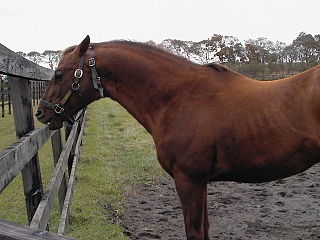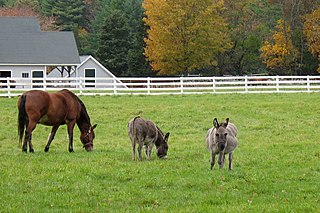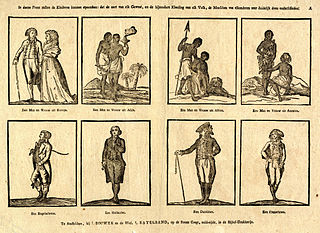
Mink are dark-colored, semiaquatic, carnivorous mammals of the genera Neovison and Mustela, and part of the family Mustelidae which also includes weasels, otters and ferrets. There are two extant species referred to as "mink": the American mink and the European mink. The extinct sea mink is related to the American mink, but was much larger. The American mink is larger and more adaptable than the European mink but, due to variations in size, an individual mink usually cannot be determined as European or American with certainty without looking at the skeleton; however, all European mink have a large white patch on their upper lip, whereas only some American mink have this marking: therefore, any mink without the patch is certainly of the American species. Taxonomically, both American and European mink were placed in the same genus Mustela, but most recently, the American mink has been reclassified as belonging to its own genus Neovison.

A tic is a sudden, repetitive, nonrhythmic motor movement or vocalization involving discrete muscle groups. Tics can be invisible to the observer, such as abdominal tensing or toe crunching. Common motor and phonic tics are, respectively, eye blinking and throat clearing.
An ethogram is a catalogue or inventory of behaviours or actions exhibited by an animal used in ethology.

Tic disorders is defined in the Diagnostic and Statistical Manual of Mental Disorders (DSM) based on type and duration of tics. Tic disorders are defined similarly by the World Health Organization.

Stereotypies are repetitive, unwavering behaviours that cease to obtain a goal and lack function. One of the most common stereotypies in horses is equine oral stereotypic behaviour, otherwise known as cribbing, wind sucking or crib-biting. Cribbing or crib biting involves a horse grasping a solid object such as the stall door or fence rail with its incisor teeth, then arching its neck, and contracting the lower neck muscles to retract the larynx. This coincides with an in-rush of air into the oesophagus producing the characteristic cribbing grunt. Usually, air is not swallowed but returns to the pharynx. Wind-sucking is a related behavior whereby the horse arches its neck and sucks air into the windpipe but does so without grasping an object. Wind-sucking is thought to form part of the mechanism of cribbing, rather than being defined as an entirely separate behavior.
Stereotypic movement disorder (SMD) is a motor disorder with onset in childhood involving repetitive, nonfunctional motor behavior, that markedly interferes with normal activities or results in bodily injury. The behavior must not be due to the direct effects of a substance or another medical condition. The cause of this disorder is not known.
A stereotype is a simplified generalization about members of a group.

Behavioral enrichment is an animal husbandry principle that seeks to enhance the quality of captive animal care by identifying and providing the environmental stimuli necessary for optimal psychological and physiological well-being. Environmental enrichment can either be active or passive, depending on whether it requires direct contact between the animal and the enrichment. A variety of enrichment techniques are used to create desired outcomes similar to an animals individual and species' history. Each of the techniques used are intended to stimulate the animal's senses similarly to how they would be activated in the wild. Provided enrichment may be seen in the form of auditory, olfactory, habitat factors, food, research projects, training, and objects.

Stable vices are stereotypies of equines, especially horses. They are usually undesirable habits that often develop as a result of being confined in a stable with insufficient exercise, boredom, hunger, excess energy or isolation. They present a management issue, not only leading to facility damage from chewing, kicking, and repetitive motion, but also lead to health consequences for the animal if not addressed. They also raise animal welfare concerns.

Alston's brown mouse, also called Alston's singing mouse, short-tailed singing mouse, or singing mouse, is a species of rodent in the family Cricetidae. It is found in Central America, from Chiapas, Mexico, to western Panama.
Animal psychopathology is the study of mental or behavioral disorders in animals.

N-n-Propylnorapomorphine (NPA) is an aporphine derivative dopamine agonist closely related to apomorphine. In rodents it has been shown to produce hyperactivity, stereotypy, hypothermia, antinociception, and penile erection, among other effects. Notably, its effects on locomotion are biphasic, with low doses producing inhibition and catalepsy and high doses resulting in enhancement of activity. This is likely due to preferential activation of D2/D3 autoreceptors versus postsynaptic receptors, the latter of which overcomes the former to increase postsynaptic dopaminergic signaling only with high doses.

In social psychology, a stereotype is an over-generalized belief about a particular category of people. Stereotypes are generalized because one assumes that the stereotype is true for each individual person in the category. While such generalizations may be useful when making quick decisions, they may be erroneous when applied to particular individuals. Stereotypes encourage prejudice and may arise for a number of reasons.

Umespirone (KC-9172) is a drug of the azapirone class which possesses anxiolytic and antipsychotic properties. It behaves as a 5-HT1A receptor partial agonist (Ki = 15 nM), D2 receptor partial agonist (Ki = 23 nM), and α1-adrenoceptor receptor antagonist (Ki = 14 nM), and also has weak affinity for the sigma receptor (Ki = 558 nM). Unlike many other anxiolytics and antipsychotics, umespirone produces minimal sedation, cognitive/memory impairment, catalepsy, and extrapyramidal symptoms.

BMY-14802, also known as BMS-181100, is a drug with antipsychotic effects which acts as both a sigma receptor antagonist and a 5-HT1A receptor agonist. It also has affinity for the 5-HT2 and D4 receptors. The drug reached phase III clinical trials for the treatment of psychosis but was never marketed.

Abnormal behavior of birds in captivity can be defined in several ways. Statistically, 'abnormal' is when the occurrence, frequency or intensity of a behaviour varies statistically significantly, either more or less, from the normal value. This means that theoretically, almost any behaviour could become 'abnormal' in an individual. Less formally, 'abnormal' includes any activity judged to be outside the normal behaviour pattern for captive birds of that particular class or age. For example, running rather than flying may be a normal behaviour and regularly observed in one species, however, in another species it might be normal but becomes 'abnormal' if it reaches a high frequency, or in another species it is rarely observed and any incidence is considered 'abnormal'. This article does not include 'one-off' behaviours performed by individual birds that might be considered abnormal for that individual, unless these are performed repeatedly by other individuals in the species and are recognised as part of the ethogram of that species.
Polydipsia is an excessively large water intake. Its occurrence in captive birds has been recorded, although it is a relatively rare abnormal behaviour.











